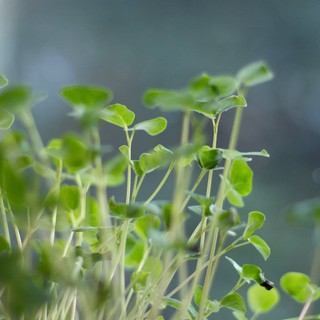The beginner’s guide to start growing microgreens

If you’re a beginner gardening, looking to try growing plants indoors, consider growing your own microgreens as an introductory project. Growing your own fresh microgreens is quite easy and straightforward when you have the necessary supplies and start with easy plants to grow.
Growing microgreens not only provides fantastic indoor gardening experience, but the resulting microgreens also provide a nutritious, flavorful addition to home cooking.
What is unique about growing microgreens?
Microgreens were first promoted in fine dining circles by high-end chefs for garnishes and flavor components. Over time these dynamos started popping up in windowsills of homes and apartments.
Many choose to grow microgreens because of the following unique qualities:
- First and foremost, these tiny plants are packed with flavor. A small amount amps up the flavor in dishes without relying on store-bought, dried seasonings.
- They have a concentrated nutrient content, providing more health benefits than mature plants.
- Microgreens are easy to grow. Within a couple of weeks of planting seeds, microgreens are ready to harvest and enjoy.
- Growing microgreens is an efficient way to use up older seeds. They are planted very thickly so a lowered germination rate due to age is less of a concern.

The enthusiast's guide to herbs
We’re proud to present our new e-book, The Enthusiast’s Guide to Herbs! Learn everything you need to know about growing and caring for herbs indoors, including in-depth info cards for the 35 most commonly grown herbs.
Click the link below to find out more!
Required skills & supplies to start growing
Growing microgreens is a gratifying way for beginners to try their hand at indoor gardening. The process is quicker and simpler than growing full-sized plants, providing results within a couple of weeks while helping to build the confidence needed o move on to more intensive indoor gardening adventures.
Skills
Overall, it’s not necessary to have an extensive gardening skill set to begin growing these sprouts indoors. Many people are successful at growing them even when they don’t consider themselves to have a green thumb which is why they are ideal for beginners.
The quick timeline from seeds to edible microgreens eliminates many of the problems associated with the care and upkeep of full-sized vegetables or houseplants.
One of the best parts about growing microgreens as a beginner is there isn’t a need to have extensive gardening skills. The most important skill to possess (or learn) is keeping a close eye on the seeds/plants to maintain adequate moisture levels and sunlight exposure. The environment needs to stay moist without being too wet; seeds and newly growing microgreens require more moisture than full-sized plants but overwatering can initiate mold or other fungal problems. There also needs to be adequate sunlight to drive photosynthesis and facilitate plant growth.
Supplies
Growing Trays or Containers: One of the great things about growing microgreens is they are fairly forgiving about what types of growing trays or containers you use. Some people choose to use dedicated seed trays, and others simply use containers they have on hand at home.
Seed trays are a good option to use if you’re growing a large number of microgreens. They are designed specifically with seed germination in mind – wide and shallow since root systems won’t fully develop – and have drainage holes in the bottom to allow excess water to drain freely.
If you’re looking for a simple and easy way to start growing microgreens then look no further than Hamama microgreen kits.
Trays can be bought through online retailers or locally at garden centers or big box stores. When purchasing seed trays look for ones that are extra thick and made from food-grade, BPA free plastic. The upfront cost is slightly higher than trays made from thinner, flimsy plastic but they last longer, negating the need to buy trays often. If available purchase ventilated dome lids that match the tray size. Lids are made from clear plastic to allow sunlight through, helping to maintain the correct humidity level.
Instead of purchasing dedicated seed trays, you can choose to recycle plastic containers from food items. Bonus if they have a lid!
- Strawberry containers
- Cupcake containers
- Salad containers
- Frozen food trays
- Egg cartons
*Growing Media: Choosing a good quality growing media for seeding trays is important: it acts as a reservoir for moisture, it provides “empty” space for air around the roots, and it supports the plants by anchoring the roots. Commercial potting soil has been a preferred media historically in greenhouse systems, but over the last few years, coconut coir has been increasingly used as an environmentally friendly alternative in horticultural production.[1] Both are lightweight and have incredible water holding capacity.
*Seeds: There are two trains of thought when it comes to buying seeds to grow microgreens. Some people prefer to purchase seeds intended for growing microgreens or sprouts, others use whatever they can purchase locally or leftover seed from previous gardening years.
When buying seeds use a dependable source and opt for untreated seeds if possible. Gardening seeds are routinely treated with fungicides. When growing seeds to mature plants this poses little threat as the growing season is long, allowing ample time for chemicals to degrade. But the growing window is incredibly shorter when growing microgreens, increasing the chance the fungicide could still be present on tender, young plants.
*Water: Keeping the growing media moist, as well as maintaining a moderate relative humidity is critical to growing microgreens. Rainwater, bottled water, and well water are the three best water sources for watering your microgreens. Bottled spring water is better than distilled water; tap water is okay if you don’t have a water softener. Avoid softened water because it contains high levels of salts that can damage sensitive microgreens.
*Sunlight: When grown outside edible plants prefer full-sun locations. Adequate sunlight is needed to drive photosynthesis, a process within the plant that creates glucose for food to fuel plant growth.[2] Indoors they prefer spots that receive 10-12 hours of sun.
If there isn’t enough direct sunlight indoors for your microgreens, supplement natural sunlight with a grow using with incandescent or fluorescent bulbs. Inadequate lighting results in tall, spindly plants that lack flavor.

Easiest microgreens to grow
Growing microgreens is a relatively easy process, but there are some plants that are even easier than others. The best options for a beginner are pea shoots, radishes, and mustard microgreens.
Pea Shoots
Pea shoots contain numerous antioxidants as well as many anti-inflammatory benefits. Packed with vitamins, folic acid, and carotenoids they help promote eye health. The fiber and proteins aid in stabilizing blood sugar levels, and case studies show a reduced risk of gastric and colorectal cancers when consumed regularly.[3] [4]
Best Varieties to Grow: Use any commonly grown variety of garden, snow or snap peas. Growing pea microgreens is a convenient way to use up leftover seeds from the previous gardening season.
Days to Harvest: 10 days to 2 weeks.
Radish
Radishes are a rich source of ascorbic and folic acid, potassium, vitamin B6, riboflavin, magnesium, copper, zinc, iron, selenium, and calcium, providing many health-related benefits when consumed.
Best Varieties to Grow: Sango, Red Arrow, Japanese Daikon, and Triton are the most popular.
Days to Harvest: Ready in 10-12 days from planting date, one of the quickest microgreens to reach harvestable size.
Mustard Greens
Mustard greens have extraordinarily high levels of antioxidants, especially vitamin A (177% of recommended daily value) and vitamin C (59% of recommended daily value). These superfoods cleanse the liver and pull toxins from the bloodstream because of their chlorophyll content. High concentrations of phytonutrients and fiber help to lower the risk of heart disease, obesity, and diabetes.
Best Varieties to Grow: Florida Broadleaf, Green Wave, Southern Giant Curled, Ruby Streaks, Red Giant, Osaka Purple
Days to Harvest: Ready for harvest in as little as 8 - 10 days, depending on the variety.
Why are some microgreens difficult to grow?
For the most part, many plants grow well as microgreens but there are some that are more difficult to grow than others. Plants such as basil, brown mustard, chia, flax, arugula, and curled cress have mucilaginous seeds. When these seeds get wet they produce a gel around the seed husk to protect it and adhere the seed to the soil.[5] This gel is a survival mechanism, an adaptation created to keep the seed hydrated and in place during times of drought or in soils susceptible to erosion. While it helps in native conditions it creates challenges for growing these plants as microgreens.
Conclusion
Growing microgreens is a fantastic way for beginners to start indoor gardening. These unique plants provide a tremendous amount of nutrition and flavor when consumed, and require little in terms of skills, making them a successful venture even for those who think they don’t have a green thumb. All that is needed to get started is some containers, growing media, and seeds. Add in some water and sunlight and within a couple of weeks, you can reap the benefits of your work!

Join our email club—get printable info cards free!
Sign up to receive our newsletter and get access to 10 printable plant info cards from our e-book for free. Also receive:
- $4 discount code for our Guide to Herbs e-book
- Semi-weekly plant inspiration & bite-size tips and tricks
Xiong, J., Tian, Y., Wang, J., Liu, W., & Chen, Q. (2017). Comparison of Coconut Coir, Rockwool, and Peat Cultivations for Tomato Production: Nutrient Balance, Plant Growth and Fruit Quality. Frontiers in Plant Science, 8, 1327. doi: 10.3389/fpls.2017.01327 ↩︎
Smithsonian Science Education Center STEMvisions Blog. (2017, April 12). Retrieved January 7, 2019, from https://ssec.si.edu/stemvisions-blog/what-photosynthesis ↩︎
De Stefani, E., Correa, P., Boffetta, P., Deneo-Pellegrini, H., Ronco, A. L., Mendilaharsu, M. (2004). Dietary patterns and risk of gastric cancer: a case-control study in Uruguay. Gastric Cancer, 7, 211. doi: 10.1007/s10120-004-0295-2 ↩︎
Zhu, B., Sun, Y., Qi, L., Zhong, R., & Miao, X. (2015). Dietary legume consumption reduces risk of colorectal cancer: evidence from a meta-analysis of cohort studies. Scientific reports, 5, 8797. doi: 10.1038/srep08797 ↩︎
Engelbrecht, M., Bochet, E., & García-Fayos, P. (2014) Mucilage secretion: an adaptive mechanism to reduce seed removal by soil erosion? Biological Journal of the Linnean Society, 111(2), 241–251. doi: https://doi.org/10.1111/bij.1219 ↩︎
